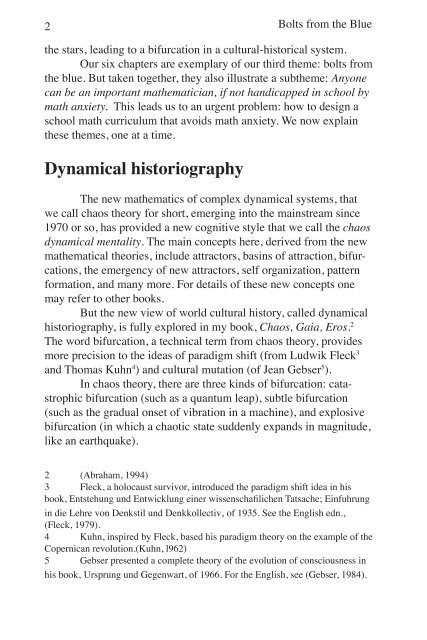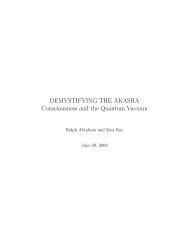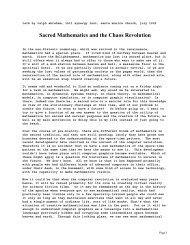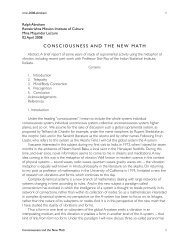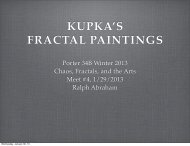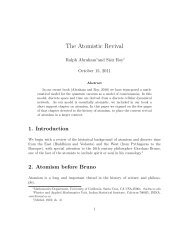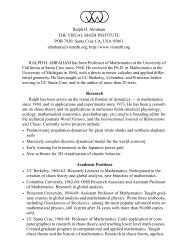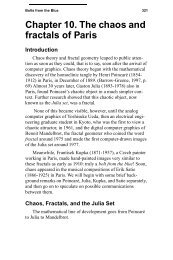BOLTS from the BLUE - Ralph Abraham
BOLTS from the BLUE - Ralph Abraham
BOLTS from the BLUE - Ralph Abraham
Create successful ePaper yourself
Turn your PDF publications into a flip-book with our unique Google optimized e-Paper software.
2 Bolts <strong>from</strong> <strong>the</strong> Blue<br />
<strong>the</strong> stars, leading to a bifurcation in a cultural-historical system.<br />
Our six chapters are exemplary of our third <strong>the</strong>me: bolts <strong>from</strong><br />
<strong>the</strong> blue. But taken toge<strong>the</strong>r, <strong>the</strong>y also illustrate a sub<strong>the</strong>me: Anyone<br />
can be an important ma<strong>the</strong>matician, if not handicapped in school by<br />
math anxiety. This leads us to an urgent problem: how to design a<br />
school math curriculum that avoids math anxiety. We now explain<br />
<strong>the</strong>se <strong>the</strong>mes, one at a time.<br />
Dynamical historiography<br />
The new ma<strong>the</strong>matics of complex dynamical systems, that<br />
we call chaos <strong>the</strong>ory for short, emerging into <strong>the</strong> mainstream since<br />
1970 or so, has provided a new cognitive style that we call <strong>the</strong> chaos<br />
dynamical mentality. The main concepts here, derived <strong>from</strong> <strong>the</strong> new<br />
ma<strong>the</strong>matical <strong>the</strong>ories, include attractors, basins of attraction, bifurcations,<br />
<strong>the</strong> emergency of new attractors, self organization, pattern<br />
formation, and many more. For details of <strong>the</strong>se new concepts one<br />
may refer to o<strong>the</strong>r books.<br />
But <strong>the</strong> new view of world cultural history, called dynamical<br />
historiography, is fully explored in my book, Chaos, Gaia, Eros. 2<br />
The word bifurcation, a technical term <strong>from</strong> chaos <strong>the</strong>ory, provides<br />
more precision to <strong>the</strong> ideas of paradigm shift (<strong>from</strong> Ludwik Fleck 3<br />
and Thomas Kuhn 4 ) and cultural mutation (of Jean Gebser 5 ).<br />
In chaos <strong>the</strong>ory, <strong>the</strong>re are three kinds of bifurcation: catastrophic<br />
bifurcation (such as a quantum leap), subtle bifurcation<br />
(such as <strong>the</strong> gradual onset of vibration in a machine), and explosive<br />
bifurcation (in which a chaotic state suddenly expands in magnitude,<br />
like an earthquake).<br />
2 (<strong>Abraham</strong>, 1994)<br />
3 Fleck, a holocaust survivor, introduced <strong>the</strong> paradigm shift idea in his<br />
book, Entstehung und Entwicklung einer wissenschafilichen Tatsache; Einfuhrung<br />
in die Lehre von Denkstil und Denkkollectiv, of 1935. See <strong>the</strong> English edn.,<br />
(Fleck, 1979).<br />
4 Kuhn, inspired by Fleck, based his paradigm <strong>the</strong>ory on <strong>the</strong> example of <strong>the</strong><br />
Copernican revolution.(Kuhn, l962)<br />
5 Gebser presented a complete <strong>the</strong>ory of <strong>the</strong> evolution of consciousness in<br />
his book, Ursprung und Gegenwart, of 1966. For <strong>the</strong> English, see (Gebser, 1984).


